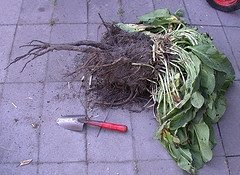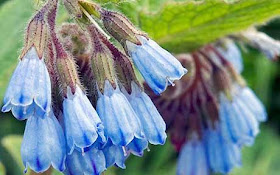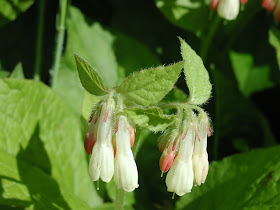Comfrey is a "must have" plant in the Forest Garden.
Common Name: Comfrey
Scientific Names:
- Symphytum asperum (Rough/Prickly Comfrey):
- Symphytum ibericum (Dwarf Comfrey): 12-16” tall and wide
- Symphytum grandiflorum (Large-Flowered Comfrey): 8-12” tall, 18” wide
- Symphytum officianale (Wild/Common/Medicinal Comfrey): 3-5’ tall and wide
- Symphytum orientale (White Comfrey): 2-3’ tall, 12-18” wide
- Symphytum tuberosum (Tuberous Comfrey): 1-2” tall and wide
- Symphytum x uplandicum (Russian/Caucasian/Quaker/Blue Comfrey) = natural hybrid of S. asperum and S. officinale: 1-4’ tall, 3’ wide
Family: Boraginaceae (the Borage or Forget-me-Not Family)
Comfrey growing as companion plants to fruit bushes.
Description:
Comfrey is a fast-growing, perennial, herbaceous, clump-forming plant typically with a deep tap-root (that helps draw up nutrients), large leaves (that can be cut and dropped in place or moved to an area where you want/need those nutrients), and small, pretty flowers (that attract a large number of beneficial insects). It can grow in a wide range of growing conditions. It is an ideal "fertilizer" plant in the Forest Garden.
History:
- Comfrey is a native to Europe and Asia.
- It has been cultivated since around 400 B.C.
- Used medicinally in China for over 2,000 years.
- First brought to Britain in 1800.
- WIld Comfrey was shipped to North America by English immigrants and Russian Comfrey was shipped to Canada in 1954.
Trivia:
- The name "comfrey" comes from the Latin for "grow together" - even ancient people understood the value of Comfrey!
- Also known as “knitbone” after its traditional medicinal use in assisting the healing of broken bones.
Comfrey's small flowers attract a lot of beneficial insects.
USING THIS PLANT
Primary Uses:
- Mulch – can be cut 1-2 x per year (4-5 x per year if fertilized) to about 2 inches above ground and used as a green or “chop and drop” mulch. Avoid harvest in the first season.
- Liquid Fertilizer - steeping chopped Comfrey leaves in water for several weeks produces a thick, dark liquid that can be diluted with water and "fed" to plants.
- Mineral Accumulator – high in potassium, but also phosphorus, calcium, Copper, Iron, and Magnesium
- Ground Cover – lower growing species can tolerate some foot traffic, plant 2-3 feet apart.
- General insect (especially bees) nectar and pollen plant
- Lacewings prefer to lay eggs on Comfrey
- Spiders prefer to overwinter on Comfrey
- Parasitoid Wasps and Spiders prefer to spend time and hunt on and around Comfrey
Secondary Uses:
- Fresh eating – only Symphytum officianale (Common/Medicinal Comfrey) and Symphytum x uplandicum (Russian/Quaker Comfrey). Best when cooked.
- Forage crop for pigs, sheep, and poultry, but reportedly cattle and rabbits don't like fresh leaves (only wilted).
- Medicinal – long history of use in aid of wound and bone healing.
Comfrey has medium to large leaves, and some species have tiny hairs on them.
DESIGNING WITH THIS PLANT
AHS Heat Zone: No reliable information found
Chill Requirement: No reliable information found, but likely not required.
Plant Type: Small Tree to Medium-sized Herbaceous Shrub (while frost resistant, continued freezing weather will kill back above ground growth).
Leaf Type: Deciduous
Forest Garden Use: Herbaceous Layer and Ground Cover/Creeper Layer
Cultivars/Varieties: Many species/varieties available.
Pollination: Self-Pollinating/Self-Fertile
Flowering: May-September (depending on the species)
Life Span: No reliable information available
Comfrey roots are big and deep... perfect to break up hard soil and mine nutrients.
PHYSICAL CHARACTERISTICS OF THIS PLANT
Size: See individual species list above
Roots: Some have rhizomatous and others have fibrous tap roots - deep and expansive
Growth Rate: Fast
Comfrey's flowers come in a wide range of colors: purple, pink, blue, white, yellow... beautiful!
GROWING CONDITIONS FOR THIS PLANT
Light: Prefers full sun
Shade: Tolerates light shade (about 50%)
Moisture: Medium, some species can be a bit more drought tolerant
pH: tolerates a wide range (6.5-8.5)
Special Considerations for Growing:
This is a great species to plant under fruiting trees. If you want to “chop and drop” frequently as a green mulch, consider fertilization with urine (yeah… just pee on it!) as a simple way to boost growth.
Propagation:
- Can be propagated through root cuttings in Winter and Spring – should be planted about 2 inches deep.
- Division in Spring.
- Symphytum officianale (Common/Medicinal Comfrey) can self-seed.
Maintenance: Minimal.
Concerns:
- Can be spreading. (Note: the use of "Bocking 14" cultivar is sterile and prevents its spread)
- Can be hard to eradicate.
- Poisonous – all parts of the plant contains pentacylic alkaloids (regular consumption can cause liver toxicity)
- Note that leaves and stems are covered in small hairs that can irritate the skin.
Harvesting Comfrey... pretty easy with such large leaves.











Yes, comfrey is a definite must in the garden. Comfrey poultices helped Hubby this winter with healing his cracked ribs when he slipped and fell on the ice. The pioneers knew well to call it "Boneknit". Appreciate all of the detailed info you post!
ReplyDeleteI am gonna plant it in my backyard.
DeleteNice video on the uses of comfrey here: http://www.permaculture.co.uk/videos/least-12-reasons-plant-comfrey-symphytum-officinale-your-permaculture-garden
ReplyDeleteBeth
I have grown Comfrey successfully for 20 yrs. in Illinois. We moved to Florida a year ago and brought several plants (potted) to transplant as I usually did. It grew well and then it started to turn yellow so I watered it more and it seemed to come back. But it has died off. Now we are in the 'winter' part of Florida and I am hoping it is just in its dormant state, because in Illinois it did so in the winter and then always returned. I planted it in the 'sand' however I mixed it well with potting soil. I am not used to dealing with so much sand and I am trusting I have not lost my comfrey. Do you have any comments to give me hope. Puzzled gardner.
ReplyDeleteBefore I learned of permaculture, we had common comfrey as a "weed" in our garden.(of course we always tilled, and it spread everywhere!!!) Now I see it in a whole new way, and will be taking it to my new property. Thanks John and Permaculture!
ReplyDeleteRe: subdivision, we have subdivided as late as the end of September (we're in US Zone 4) with no problem. We pot up divisions and inoculate with mycorrhizal fungi. When the plants put out new leaves and showed root growth at the pot drainage holes - about 3 weeks, we planted them out.
ReplyDeleteIf anyone in Washington state (USA) is looking for Russian Comfrey (non-seed forming type) I always have extra available for trade (local pickup).
ReplyDeletehttps://www.facebook.com/groups/PermacultureSwapWashingtonState/permalink/1894735154096357/?sale_post_id=1894735154096357
I've got Iberian comfrey which is a great ground cover and bee plant, but does anyone know if it shares the benefits of officinale and uplandicum e.g. bioaccumulation, fertiliser, medical?
ReplyDeleteI have a small comfery growing all over my garden, it was there when we bought the place and the garden was the original garden of long ago! It is small and compact with lovely yellow flowers, it seeds easily. Can anyone tell me about it?
ReplyDeleteI also would like to know if courgettes/zuccini like comphery?
The very first thing you’ll want to do after receiving your credit card is to verify its receipt and activate your Capital One Credit Card at Capitalone.com/activate. JCPenney Gift Card Balance
ReplyDeleteThanks for sharing this post visit my site
ReplyDeleteI want to share a testimony on how i got cured totally from Genital Herpes with the help of the herbal remedy i ordered from Dr Ogudugu, i was diagnosed of Genital Herpes 2019 i have been using my Doctor recommended drugs to control the blisters outbreaks but one day i saw a post by someone on how Dr Ogudugu cured her with his herbal remedy, so i decided to give it a try i contacted Dr Ogudugu and he told me how to order the medicine and i did, he sent the medicine to me through DHL delivery service. I took the medicine for 2 weeks and today i am totally cured from herpes and my Doctor confirmed it through a lab test. You can contact Dr Ogudugu through EMAIL: greatogudugu@gmail.com OR HIS WHATSAPP: +2348163026536.
ReplyDeletecw450kvbpl
ReplyDeletegolden goose outlet
golden goose outlet
supreme outlet
golden goose outlet
golden goose outlet
golden goose outlet
golden goose outlet
golden goose outlet
golden goose outlet
golden goose outlet